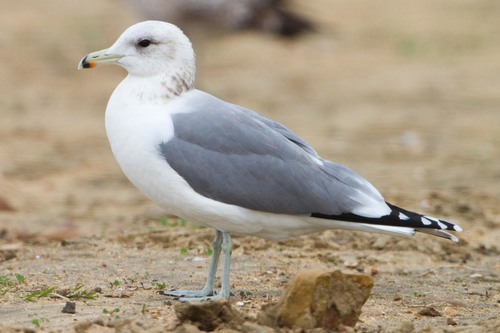
California Gull
The California Gull (*Larus californicus*) is a medium-sized gull common in western North America. It plays a significant ecological role as both a predator and scavenger, helping to regulate populations of invertebrates and clean up carrion. While not as strongly associated with coastal areas as some other gull species, it breeds inland near lakes and marshes. It holds particular cultural significance in Utah, where it is the state bird and is credited with saving early Mormon settlers' crops from a cricket plague in 1848, a historical event known as the 'Miracle of the Gulls'.
46-55 cm
Length
122-137 cm
Wingspan
Least Concern
Conservation Status
Distribution
Breeds primarily in the interior of western North America, from the Northwest Territories and Canadian Prairies south to California, Nevada, Utah, and Colorado. Winters along the Pacific coast from southern British Columbia to Mexico. Some populations are resident year-round, while others undertake significant migrations.
Lifespan
Typically 10-15 years in the wild, with a maximum recorded lifespan of over 24 years.
California Gull's Habitat
Habitat Types
Freshwater lakes, Saline lakes, Marshes, Reservoirs, Coastal estuaries (during winter), Beaches (during winter), Agricultural fields (during migration and winter)
Climate Zones
Temperate, Boreal (breeding range), Subtropical (wintering range)
Adaptations
Tolerant of a wide range of salinity levels in breeding lakes. Opportunistic feeding habits allow it to exploit diverse food sources in different habitats.
Variations
Two subspecies are generally recognized: *L. c. californicus* and *L. c. albertaensis*. *L. c. albertaensis* is slightly larger and darker, breeding primarily in the northern part of the range.
Appearance
Breeding Plumage
Breeding adults have a white head, body, and tail, with a light gray back and upperwings. Nonbreeding adults have brown streaking on the head and neck. The bill is yellow with a black ring near the tip, and a red spot on the lower mandible. Legs are yellowish-green.
Seasonal Feather Changes
Head streaking is more pronounced in winter (non-breeding plumage) and reduced or absent in summer (breeding plumage).
Sex Based Plumage Differences
Limited sexual dimorphism in plumage; males and females are visually similar.
Notable Features
Yellow bill with a black ring and red spot., Yellowish-green legs., Dark eye., White head in breeding plumage.
Diet and Feeding
Primary Foods
Insects, Fish, Earthworms, Rodents, Eggs and chicks of other birds, Carrion, Garbage, Agricultural grains
Foraging Behavior
Highly adaptable and opportunistic. Forages while walking, wading, swimming, or flying. Will steal food from other birds (kleptoparasitism). Often follows plows to feed on exposed invertebrates. Dips and dives for fish near the water surface.
Specializations
No highly specialized feeding adaptations; generalist diet allows for flexibility in different environments.
Seasonal Diet Variations
Diet shifts with food availability. Insects are a major food source during the breeding season, while fish and garbage may be more important in winter.
Behavior
Social Structure
Highly colonial during the breeding season, nesting in large groups on islands or isolated shorelines. Forms flocks outside of the breeding season, often congregating at feeding sites.
Communication
A variety of calls, including a long call used for territorial defense and mate attraction., Visual displays, such as head-tossing and wing-spreading.
Migration
Most populations are migratory, moving from inland breeding areas to the Pacific coast for the winter. Migration is typically in flocks.
Territorial or Group Behaviors
Defends nesting territories vigorously against other gulls and predators. Forms large communal roosts, especially during the non-breeding season.
Conservation
Threats
Habitat loss and degradation (wetland drainage), Water pollution, Human disturbance at breeding colonies, Changes in water levels at breeding lakes, Pesticide exposure
Protection Programs
Migratory Bird Treaty Act protection, Some breeding colonies are protected within national wildlife refuges or state parks.
Local National Laws
Protected under the Migratory Bird Treaty Act in the United States and Canada.
Population Trend
Stable
Population Estimates
Estimated at over 500,000 individuals.
Interesting Facts
The California Gull is the state bird of Utah.
This is due to the 'Miracle of the Gulls' in 1848, when gulls are credited with saving the crops of Mormon settlers from a cricket infestation.
They can drink both freshwater and saltwater.
They have specialized salt glands above their eyes that excrete excess salt, allowing them to survive in saline environments.
California Gulls are known to hybridize with other gull species.
Hybridization has been documented with Ring-billed Gulls and Herring Gulls, although it is relatively uncommon.
Faqs about California Gull
Are California Gulls aggressive?
They can be aggressive when defending their nests and young, but generally avoid direct conflict with humans unless provoked.
What do I do if I find an injured California Gull?
Contact a local wildlife rehabilitator or animal control agency. Do not attempt to handle the bird yourself, as they can bite and scratch. Consult a professional for expert advice.
Why are they called 'California' Gulls if they breed inland?
The species was first described from specimens collected in California, which is a major wintering area for the species.
Copyright @ Nature Style Limited. All Rights Reserved.
 English
English